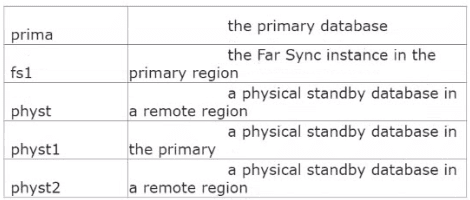Oracle 1z0-076 - Oracle Database 19c: Data Guard Administration
You created two remote physical standby databases using SQL and RMAN.
The primary database is a four-instance RAC database and each physical standby database has two instances.
Roles-based services are used for client connectivity and have been defined in the Grid Infrastructure.
Consider these operational requirements:
• The ability to manage multiple standby databases with a single tool
• The simplification of switchovers, failovers, reinstatements, and conversions to and from snapshot standby databases
• The automation of failovers to a specified target standby database
Which TWO tools can be used to fulfill these requirements7
Your expertise is requested for these customer requirements:
The Data Guard environment must be in maximum protection mode.
Reports must be offloaded to a physical standby database.
There must be no lag between the primary and standby databases that affect the reports produced.
The primary database must be resilient in case of a single network failure.
Which solution is correct for these requirements?
Your Data Guard environment consists of these components and settings:
A primary database supporting an OLTP workload
A remote physical standby database
Real-time query is enabled
The redo transport mode is set to SYNC
The protection mode is set to Maximum Availability
Which two statements are true regarding the DelayMins database property for the standby database?
Which four statements are true regarding SQL Apply filters for a logical standby database?
A Data Guard environment has this configuration and these attributes:
The primary database prima is in the local region.
A physical standby database physt1 is in the local region.
A physical standby database physt2 is in a remote region.
The primary ships redo to physt1.
physt1 ships redo to physt2.
physt1 and physt2 have Real-Time Query enabled.
A sequence has been created with this SQL statement in the primary database:
CREATE SEQUENCE a NOCACHE SESSION;
Which TWO statements are TRUE?
You must design an Oracle Data Guard configuration for a DSS database that meets these permanent
requirements:
1. Creating and maintaining bitmap indexes should not impact the performance of the primary database.
2. Creating and maintaining materialized views should not impact the performance of the primary database.
Additionally, there are these requirements, only one of which is ever done at any one time:
1. It should be possible to apply designated patches with a minimum amount of downtime.
2. Upgrading to a new database release should be performed with the least possible amount of downtime.
3. New application software releases should be tested against an exact and up-to-date replica of the primary database.
Which configuration meets these requirements with the fewest of databases?
A customer has these requirements for their proposed Data Guard implementation:
1. Zero data loss must still be guaranteed through the loss of any one configuration component.
2. The primary database must be protected against a regional disaster.
3. Performance overheads on the primary should be minimized as much as possible given these requirements.
4. Downtime on the primary database for any reason must be kept to a minimum.
Components referred to in the broker commands are:

A)

B)

C)

D)

Which FOUR database parameters might be affected by or influence the creation of standby databases?
Which THREE steps are prerequisites for the creation of a physical standby database on a separate server using the RMAN active database duplication method?
There are currently 6 applief. and 6 pfepafef processes running and no idle applier processes on y logical standby database.
The max_SERVERS SQL apply parameter and number of archiver processes are both set to 12.
Identify two changes, each of which would allow you to increase the number of applier processes.



